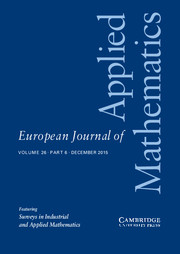Crossref Citations
This article has been cited by the following publications. This list is generated based on data provided by
Crossref.
Maulik, Romit
Garland, Nathan A.
Burby, Joshua W.
Tang, Xian-Zhu
and
Balaprakash, Prasanna
2020.
Neural network representability of fully ionized plasma fluid model closures.
Physics of Plasmas,
Vol. 27,
Issue. 7,
Renganathan, S. Ashwin
Maulik, Romit
and
Rao, Vishwas
2020.
Machine learning for nonintrusive model order reduction of the parametric inviscid transonic flow past an airfoil.
Physics of Fluids,
Vol. 32,
Issue. 4,
BURGER, M.
E, W.
RUTHOTTO, L.
and
OSHER, S. J.
2021.
Connections between deep learning and partial differential equations.
European Journal of Applied Mathematics,
Vol. 32,
Issue. 3,
p.
395.
Gin, Craig R.
Shea, Daniel E.
Brunton, Steven L.
and
Kutz, J. Nathan
2021.
DeepGreen: deep learning of Green’s functions for nonlinear boundary value problems.
Scientific Reports,
Vol. 11,
Issue. 1,
Baumann, Henry
Schaum, Alexander
and
Meurer, Thomas
2022.
Data-driven control-oriented reduced order modeling for open channel flows.
IFAC-PapersOnLine,
Vol. 55,
Issue. 26,
p.
193.
Kalu, Ikechukwu
Ndehedehe, Christopher E.
Okwuashi, Onuwa
Eyoh, Aniekan E.
and
Ferreira, Vagner G.
2022.
Geodetic first order data assimilation using an extended Kalman filtering technique.
Earth Science Informatics,
Vol. 15,
Issue. 4,
p.
2585.
Bahmani, Bahador
and
Sun, WaiChing
2022.
Manifold embedding data-driven mechanics.
Journal of the Mechanics and Physics of Solids,
Vol. 166,
Issue. ,
p.
104927.
Kalu, Ikechukwu
Ndehedehe, Christopher E.
Okwuashi, Onuwa
and
Eyoh, Aniekan E.
2022.
A comparison of existing transformation models to improve coordinate conversion between geodetic reference frames in Nigeria.
Modeling Earth Systems and Environment,
Vol. 8,
Issue. 1,
p.
611.
Heaney, Claire E.
Wolffs, Zef
Tómasson, Jón Atli
Kahouadji, Lyes
Salinas, Pablo
Nicolle, André
Navon, Ionel M.
Matar, Omar K.
Srinil, Narakorn
and
Pain, Christopher C.
2022.
An AI-based non-intrusive reduced-order model for extended domains applied to multiphase flow in pipes.
Physics of Fluids,
Vol. 34,
Issue. 5,
Fieseler, C.
Mitchell, C. A.
Pyrak‐Nolte, L. J.
and
Kutz, J. N.
2022.
Characterization of Acoustic Emissions From Analogue Rocks Using Sparse Regression‐DMDc.
Journal of Geophysical Research: Solid Earth,
Vol. 127,
Issue. 7,
Laperre, B.
Amaya, J.
Jamal, S.
and
Lapenta, G.
2022.
Identification of high order closure terms from fully kinetic simulations using machine learning.
Physics of Plasmas,
Vol. 29,
Issue. 3,
Kutz, J. Nathan
and
Brunton, Steven L.
2022.
Parsimony as the ultimate regularizer for physics-informed machine learning.
Nonlinear Dynamics,
Vol. 107,
Issue. 3,
p.
1801.
Brunton, Steven L.
Budišić, Marko
Kaiser, Eurika
and
Kutz, J. Nathan
2022.
Modern Koopman Theory for Dynamical Systems.
SIAM Review,
Vol. 64,
Issue. 2,
p.
229.
Lim, Joowon
and
Psaltis, Demetri
2022.
MaxwellNet: Physics-driven deep neural network training based on Maxwell’s equations.
APL Photonics,
Vol. 7,
Issue. 1,
Sholokhov, Aleksei
Liu, Yuying
Mansour, Hassan
and
Nabi, Saleh
2023.
Physics-informed neural ODE (PINODE): embedding physics into models using collocation points.
Scientific Reports,
Vol. 13,
Issue. 1,
Choi, Hyungjin
Angelis, Valerio De
and
Preger, Yuliya
2023.
Data-driven Battery Modeling based on Koopman Operator Approximation using Neural Network.
p.
1.
Nathan Kutz, J.
2023.
Machine Learning in Modeling and Simulation.
p.
149.
Xiong, Wei
Ma, Muyuan
Huang, Xiaomeng
Zhang, Ziyang
Sun, Pei
and
Tian, Yang
2023.
KoopmanLab: Machine learning for solving complex physics equations.
APL Machine Learning,
Vol. 1,
Issue. 3,
Dall'Aqua, Marcelo J.
Coutinho, Emilio J. R.
Gildin, Eduardo
Guo, Zhenyu
Zalavadia, Hardik
and
Sankaran, Sathish
2023.
Guided Deep Learning Manifold Linearization of Porous Media Flow Equations.
Poels, Yoeri
Derks, Gijs
Westerhof, Egbert
Minartz, Koen
Wiesen, Sven
and
Menkovski, Vlado
2023.
Fast dynamic 1D simulation of divertor plasmas with neural PDE surrogates.
Nuclear Fusion,
Vol. 63,
Issue. 12,
p.
126012.



